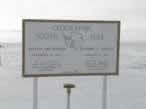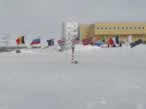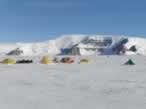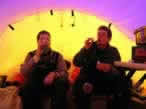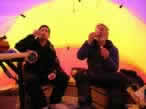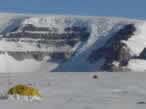The Deep South
The veil that has been obscuring continental Antarctica has finally been lifted, as I find myself in the Ohio Range entering a new year. The last days in Antarctica were essentially waiting days, passed by exercises in GPS, and eating McMurdo food.
During one session in processing GPS data, Beth, our resident NAVCO GPS expert, informed Sujoy and me that some Adelie penguins were spotted emerging from the snowstorm preventing us from traveling to the South Pole. We took our first opportunity to scramble along the road skirting the Hut Point embayment, which lies at the top of a rather steep volcanic scree descending towards the sea ice. We spotted two Adelie penguins and one emperor penguin milling about at the edge of the ice, just before the scree. We were somewhat disappointed, as the penguins were far off and hard to see. After a few minutes we turned to head back towards the lab, deciding against going closer for fear of a reprimand from NSF.
As we walked up the road, the penguins, almost as if they sensed it was their last opportunity to get a closer look at these strange red-jacket creatures at the top of the slope, began their determined ascent of the volcanic rubble. Sujoy and I halted, along with a few other penguin-watchers, and stood while the penguins set their path directly towards us! It was amazing, out of all routes, the penguins chose us as their bearing. Their ascent was accompanied by squaks and hopping, with the occasional comical faceplant as a bird would fail to negotiate a large rock in its path. Precariously balanced, wings spread wide, they still moved with about twice the speed up the slope as the average American could. Not bad for flightless sea birds!
The two Adelies neared the snow berm directly at our feet, merely a meter-and-a-half away. They did not master this particular obstacle, perhaps due to the front-end loaders roaring by, though they attempted to wallow up as if swimming… Seeing our first wild penguin was certainly a joy for us both, as I was worried there would be no opportunity on this expedition (especially once we reached our inland destination).
Upon the dissipation of the snowstorm, Robert, Sujoy, Peter and I boarded a C-130, and two hours later found ourselves where all lines of longitutude converge, and every direction points north: the South Pole. It was like landing on the moon, with a vast snow-covered ice sheet expanding as far as the eye could see in every direction. It felt wonderful to exist, if only for a little while, at the same place that Norwegian Captain Roald Amundsen first set foot on December 14, 1911. Of course now it has a very industrial appearance, with the construction of the new South Pole Station. The old station, located underneath a dome that is being buried alive by drifting snow, gives the hint of the Planet Hoth.
A ceremonial pole, and the annually surveyed geographic pole are marked just outside of the station – and are surrounded by the flags representing the member nations of the Antarctic Treaty. Just beyond the ‘pole,’ were the resultant sculptures from the Christmas celebration at South Pole Station. They were highly creative, depicting the Rapa Nui stone heads, sport cars, and various gods with sacrificial pedestals erected in front. I have a feeling that the only things sacrificing their existence were in the form of celebratory libations – but you never know with the Pole People…
We stayed at the Pole for one night, where I had the privilege of sampling a much better cup of coffee than was offered at McMurdo. I also monitored the strange effects of high-altitude on my body. I slept in a strange jamesway hut with no lighting through the main corridor (which made it bloody difficult to find my way around). I essentially had to feel my way to compartment number 5, and then rip open the shade to let the relentless sun illuminate my abode. It was a quaint little room, with the bare necessities – nice, simple, and warm.
In the morning, I spent my time man-hauling sleds full of rock boxes and frozen food to be loaded onto the Twin Otters for our trip into the field – reminiscent of a fraction of what Scott’s men Wilson, Oates, Bowers, and Evans had to endure at this very place 94 years prior. It was here that I really noticed the effect of altitude on my endurance, as I surely felt a bit more winded than usual (this of course, probably had to do with hanging around McMurdo eating copious amounts of food, as well).
Our amount of gear required at least two trips, with a third to arrive as a re-supply. Peter Braddock, our trusty mountaineer, and I left on the first trip to the Ohio Range to set up camp. After about 2.5 hours, we descended through the breathtaking cliffs and canyons of the Ohio Range! Catching a nasty downdraft in the Otter we dropped accidentally at a rate of 700 meter/second, which had my stomach in my throat for sure. But the pilots recovered from the drop, and we coasted safely to a bumpy landing on the sastrugi-ridden snow north of Darling Ridge.
The shear scale of this place is hard to qualify, or even convince yourself of while you are seeing it. The cliffs rise to about 350 meters above the ice sheet, accented by the looming 2867 meter Mt. Glossopteris and Mt. Schopf, providing an impressive backdrop for the camp Peter and I were to set up. We spent that day setting up camp, finishing around 2100h. Robert and Sujoy joined us with the second load at around 1900h, and helped us get that unpacked and set.
Once camp was in relative order, all four of us sat down to a late-night shrimp stir-fry dinner, where we brought in the New Year our first night in the Ohio Range. With a glass of wine we toasted to a productive and exciting field season, as well as to actually getting out into the field in one piece. Robert opened a package from his children, which contained fun noise-makers and bubble solution that we enjoyed over the first glass of Scotch in the year 2005. With that, we were off to bed as the sun skirted the southern sky above the Buckeye Table, illuminating what would be our home for the next month.

